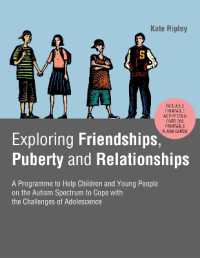Full Description
Higher Education Implications for Teaching and Learning during COVID-19 provides different perspectives regarding the impact of COVID-19 on college teaching and learning and on students, both collectively and individually. Contributors argue that the pandemic forced a higher education reckoning as institutions around the world were forced to shut their physical doors and open up their online platforms in a wider capacity. While these concerns are linked to a certain point in time, there is much we can learn from collective institutional responses to the pandemic-induced pivots to virtual teaching and learning. Scholars of higher education, organizational communication, and crisis communication will find this book particularly useful.
Contents
Chapter 1: COVID-19 Implications: Students and college teaching,
Michael G. Strawser, Melissa Looney
Chapter 2: Narrative possibilities for students who shifted to online learning during COVID-19 and what these possibilities can mean for online education in the future,
E. Michele Ramsey
Chapter 3: College students' perceptions of online learning during the pandemic,
Ben Alfonsin, Narissra M. Punyanunt-Carter
Chapter 4: Graduate Teaching Assistants' Liminality and Post-COVID-19 Educational Legacy,
Sarah E. Riforgiate, Ali Gattoni, Sierra Renee Kane
Chapter 5: The impacts of COVID-19 on graduate teaching assistants: Insights for supervisors and administrators,
Laura Alberti, Jessica Beckham, Carrie E. Reif-Stice, L. Paul Strait, and Kathryn E. Anthony
Chapter 6: African American college students stress management and wellness during COVID-19,
Bryan Michael Jenkins, Tanya E. Gardner, Wei Sun
Chapter 7: A student-centered privacy model for responsible technology use,
Alexis Shore, Anisha Reddy, Carrie Klein
Chapter 8: Student perceptions of instructor communication amid class disruption: Lessons learned from the COVID-19 pandemic,
Kristen LeBlanc Farris, Luke A. Dye, Marian L. Houser, C. Erik Timmerman
Chapter 9: From sage on the stage to host with the most,
Diane Gayeski
Chapter 10: Connecting with students in the hybrid 2.0 classroom,
Diane Monahan
Chapter 11: Using human-centered design to improve the remote teaching and learning experience,
Maureen K. McLaughlin, Sarah J. McMahon
Chapter 12: How planned synchronous interventions can improve teaching in a Post-Covid world,
Samuel Boerboom, Melissa Boehm
Chapter 13: Harnessing the power of three online learning tools: Best practices for student engagement in distance learning courses,
Angela M. McGowan-Kirsch, Amanda Lohiser, Susan Sprangler
Chapter 14: Leveraging the disruption: A call to revisit the flipped classroom in post-COVID higher education,
Heather J. Hether
About the Authors








